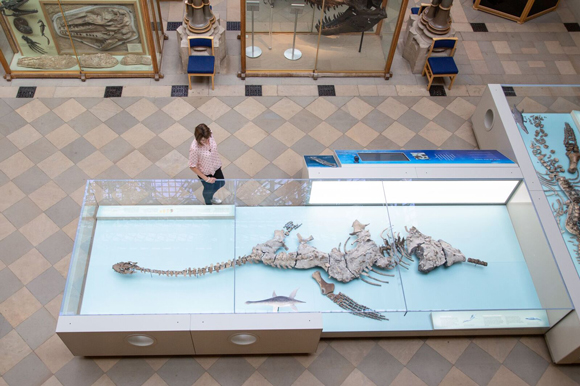Potential New Plesiosaur Species
A nearly complete plesiosaur skeleton that came to rest in marine sediments now located in northern Cambridgeshire might just prove to be a new species. The fossilised remains were excavated out of a layer of rock discovered in a fenland quarry in November 2014, by archaeologists from the Oxford Clay Working Group.
The Cambridge Plesiosaur
A nearly complete plesiosaur skeleton that came to rest in marine sediments now located in northern Cambridgeshire might just prove to be a new species. Over the next four days the team were able to excavate and remove nearly 600 bone fragments that represent a considerable portion of the entire skeleton. Only some limb elements are missing. The fossil, nick-named Eve, represents an individual around five and a half metres in length, early indications are that the bones show similarities with another plesiosaur known from the Peterborough area, called Picrocleidus.
Visit Everything Dinosaur’s award-winning website: Everything Dinosaur.
However, Picrocleidus is believed to have been much smaller, at less than half the length of this new discovery, and its fossils are associated with much younger Jurassic strata (Callovian faunal stage), whilst “Eve” was found in rocks dating from about 165 million years ago (Bathonian faunal stage of the Jurassic).
A Plesiosaur Specimen on Display

A long-necked plesiosaur fossil specimen. A plesiosaur fossil specimen on display at the Oxford University Natural History Museum.
Picture credit: Everything Dinosaur
The Oxford Clay Working Group
Dr Carl Harrington, a member of the Oxford Clay Working Group, was the first person to find bones of this new sea monster. Describing the find as “fantastic”, Dr Harrington recalled the moment he first uncovered the delicate skull bones:
It was one of those absolute “wow” moments. I was the first human to come face-to-face with this reptile.”
The quarry is owned by building supplies company Forterra and this part of Cambridgeshire has become very well known for its Jurassic vertebrate fossil finds. For example, the first fossils of the giant prehistoric fish Leedsichthys (L. problematicus) were also found in the Peterborough area. Forterra have donated the specimen to the Oxford University Museum of Natural History, where the fossilised remains are currently being prepared and studied in more detail with a view to determining whether or not this is a new species of marine reptile.
An Artist’s Interpretation of the New Marine Reptile (Plesiosaur)
Picture credit: Nobomichi Tamura with additional annotation by Everything Dinosaur
For models and replicas of plesiosaurs and other marine reptiles: CollectA Deluxe Prehistoric Life Models.
Plesiosaurs had two pairs of oar-like paddles which they used to propel themselves through the water, recent studies suggest that, just like extant penguins, these marine reptiles, some of whom could reach lengths in excess of fifteen metres, actually “flew” through the water.
To read more about this research into plesiosaur propulsion: Computer simulations and marine reptile underwater flight.
Nice to see that Cambridge is prepared to donate a pair of oars to Oxford, their bitter rowing rivals.







Leave A Comment